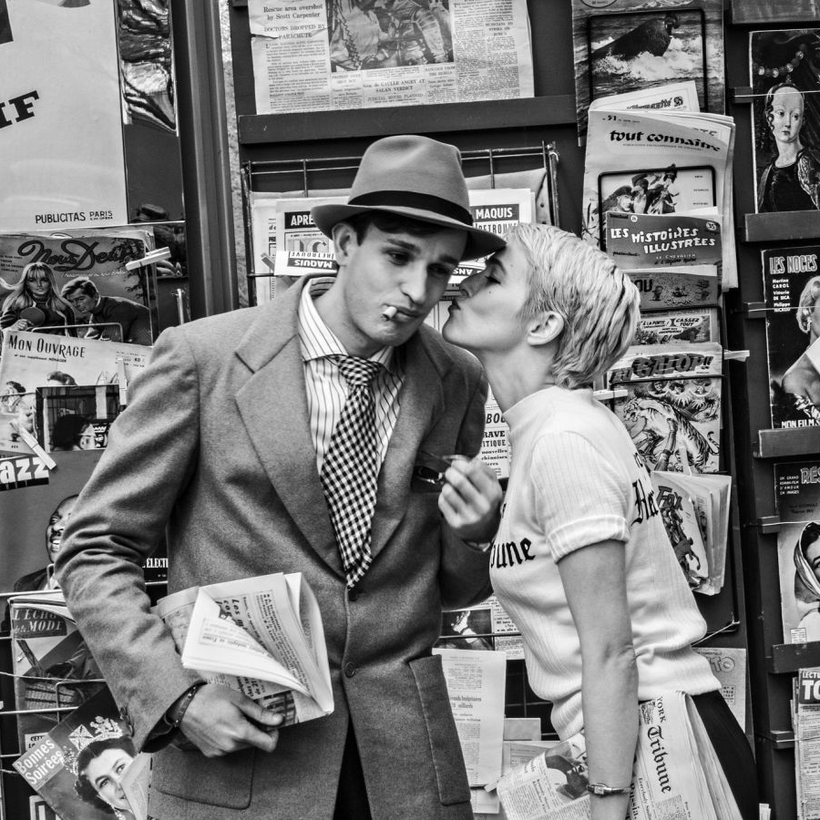Richard Linklater’s Nouvelle Vague is a black-and-white, 35-mm., 1960 French movie made today with a digital camera by a Texan who doesn’t speak French.
He gives us the sooty, contrasty old Paris of cobblestoned streets and white skies where black-haired young men talk in quotes and the only blonde is a 20-year-old movie star from Iowa. I have no idea how he managed to crawl into Jean-Luc Godard’s Breathless to reconstitute its dramatic scenes and its real-life context—the milieu of passionate cinephile, Cahiers du Cinéma film critics sweating with frustration at their typewriters because they’re not yet directing—but he did. He understood everything, and you will, too.
The film is fully French; it lacks only the opacity and—dare I say it—structural laziness that makes so many French films run out of air. It’s as if French cinema had taken the arbitrary breeziness of Godard’s Breathless as a biblical injunction and made films that detumesce halfway through, to never quite reach the apogee of any plot.

Linklater, although working with French material in French, and making a film about a film with a tiny story that ends with a stumbling ambush and an insult, is so generous in his presentation that you understand Godard and his stars and his friends and his context and his time. Linklater helpfully identifies each of the characters as if they were in a documentary, because all critics look the same in black and white.
A brisk, lighthearted masterpiece that sparkles with energy, with verve and appetite and conviction, it’s about the making of the movie that set the tone for the next 50 years of film. Linklater, who made his name with films about youth—Slacker, Dazed and Confused, Boyhood—easily conveys the erratic energy, self-seriousness, and wild jubilation of being a young man who gets the chance to fulfill his dream, and decides to do it his way and break all the rules.

The young man is Swiss, with black hair, dark glasses, and a five-o’clock shadow at noon. At 28, he’s consumed with the shame of not having made his first feature by the age of 25—a short, he tells a girl, doesn’t count—and jealous of his colleague François Truffaut, who’d made The 400 Blows the year before, when he was only 27, and was now hailed as a genius. A producer gives Godard his chance, but on a script by Truffaut.
Godard wants the American Jean Seberg—at 20, a freshly minted star after two Otto Preminger movies, Joan of Arc and Bonjour Tristesse. She accepts. He keeps his promise to cast in his first film an actor-boxer with a broken nose, just back from the Algerian war: Jean-Paul Belmondo, 26, charming, shirtless, running his thumb over his lips, who became a star with this film. He gets a great D.P., Raoul Coutard, who figures out how to hide the camera in a postal cart to discreetly shoot street scenes, and uses a wheelchair for his tracking shots.
One of the joys of Nouvelle Vague is that—apart from Seberg being played by Zoey Deutch, whom you might recognize, though not as a short-haired blonde with a beauty mark on her cheekbone—the actors in the film are all so new that they register only as the people they’re playing. So when I say that Guillaume Marbeck is wonderful as Godard, you’ll go, “Who?,” that Aubry Dullin is fantastically attractive and elastic as Belmondo, that will be another “Who?” It doesn’t matter who the actors are; it’s what they’re doing that counts.

With a 20-day shooting schedule, Godard wastes time the way other directors waste money. Relentlessly and competitively quoting dead poets, philosophers, and living directors, he dawdles, cancels work, rewrites and unwrites the script in cafés. He insists on improvised dialogue and, in the editing phase, goes long on an interview given by Jean-Pierre Melville, playing a famous writer named Parvulesco (a wonderful conflation of “parvenu” and “Ionesco”), and fills the film with close-ups of the luminous blonde from Iowa with the short hair and a striped sailor sweater, who hawks the Herald Tribune on the Champs-Elysées, turns in her lover, and at the end asks, “Qu’est ce que c’est, dégueulasse?”
For the record, dégueulasse comes from the verb dégueuler, which means to vomit. The nearest synonym is “nauseating.” “Gross” would do, but for the real sense of deliberately gross behavior that hurts another person, “shitty” would be best.
Not only is the film about making a film a delight, but the reconstitution of the film that’s being made is so precise that when you order up Godard’s original Breathless on Criterion and watch both side by side—and you will—you’ll find that Linklater places you firmly in the original scenes, but at a different angle, to bridge fact and fiction.

The only sad thing about Nouvelle Vague is that the world Linklater shows being born is now vanishing. Paris was the nouvelle vague, Paris was movies, a cinemathèque, cinemas. At the time of Breathless and the real nouvelle vague, the Champs-Elysées was lined with movie houses, too many to count accurately—though demon A.I. puts the total at an impossible 65. A cinephile could gorge on movies, then snack on papers and magazines from the plentiful green kiosks. Now the kiosks sell knickknacks and sugar water, and there is only one movie house left.
Nouvelle Vague is so welcoming that the great Spanish director Isabel Coixet has stated, “I want to live in that movie.”
The French may never forgive Linklater for having made the best film of the nouvelle vague.
Nouvelle Vague will hit theaters on October 31 and will be available for streaming on Netflix beginning November 14
Joan Juliet Buck is a writer and actress and the former editor of French Vogue. You can read her Substack here

